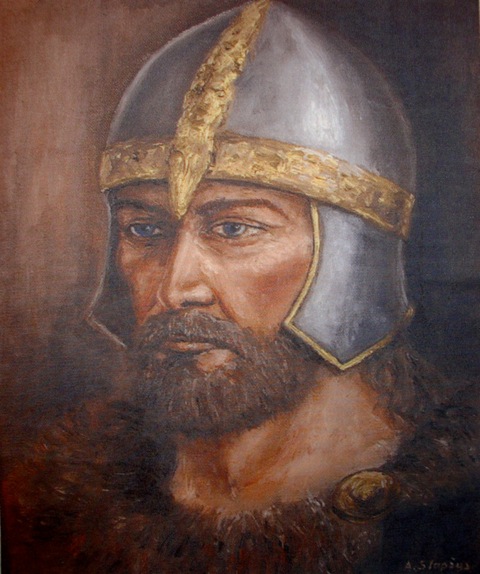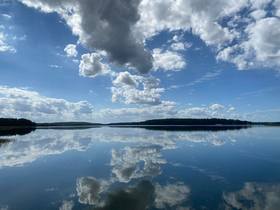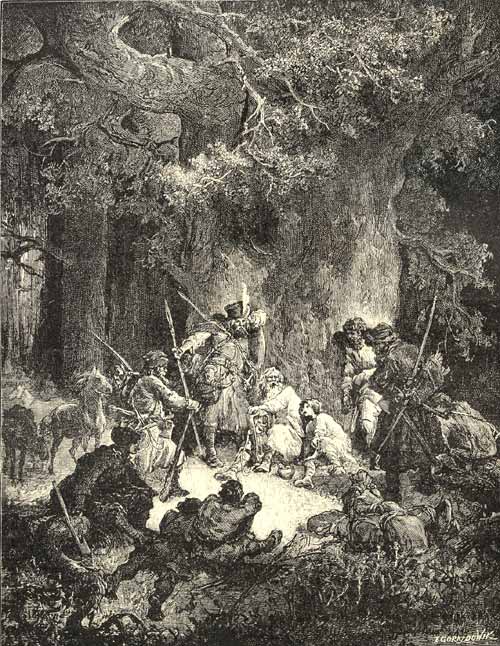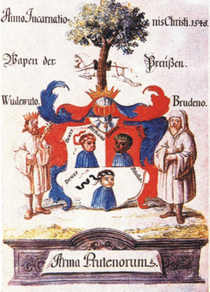
The history of ancient Prusai WHO WERE THE PRUSAI? ARCHEOLOGY COULD PRUSAI BE CHRISTIANS ? Mieszko I Poland THE ARMS AND THE WAY OF FIGHT THE CONQUEST, I, II UPRISING THE III-rd PRUSAI UPRISING The PRUSAI KNIGHTHOOD OPPOSITION What has happened to Prusai? THE GERMANIC ENSLAVEMENTS
The Battle of Grunwald
Culmland Banner The Prusai Maps
PRUSAI
Prusians Heroes Prominent Prusian Where you are, Prusai?
COAT OF ARMS
The Coat of Arms THE COAT OF ARMS PRUS I, II, III Unknown version Prus I,II, III Prus - name and Coat of Arms UNKNOWN COAT OF ARMS EUROPE MONARCHIES
PRUS DESCENDANTS
Pilewski
KURPII
The Kurppii Genesis
THE DISPUTE ABOUT HISTORY
German militarism Tadeusz Mrozinski
CULTURE
About the Prusai language The Prusai language and its sources ART AND PEOPLE Archeology Prusian Babas
PUBLICATIONS
Die Altpreußischen Personennamen Download
Elbling Dictionary
FORUM
FORUM - ARCHIVES
MAIL: PRUS@PRUSOWIE.PL
Counter
Counter

GLAPPO - THE PRUS LEADER OF WARMIAN PEOPLE
The Prusian forts and settlements were usually built on the highest hill in a given area.
Within a short distance, on the outside of every settlement, the Prusians planted specially selected bushes,
which were constantly fended. The reason for this special care was that neither horse or man could pass through
the thick growth. However the Prus settlements could not compete the brick built castles put up
by the Teutonic Knights.
The history of the Prus people, until to-day, has been written by the Germans, with the great contempt for these inhabitants.
It is high time that the history of the Prusians should be written through the prism of the murdered and later subjugated peoples.
During the Great Rising of the Prusians the inhabitants of Warmia chose for their leader the brave Glappo. It has to be said that the Warms,
Though they were not particularly active, took part in the Pomezan uprising.
Lidzbark Warminski, the ancient seat of the Warms was conquered and re-built as a Teutonic Order stronghold in 1240. The first target
for Glappo was the re-conquest of Lidzbark. Help for the Warmians arrived from the Pogezans under the leadership of Auctume. In 1261
Lidzbark Warminski was taken from the Order and for the next 13 years remained under the control of the Warmians.
The Pope seeing the danger to the Order from the Prus peoples, cancelled its participation in the expedition against the Tartars
and ordered them to stay in Prus lands. This documents the close attention he paid to the course of events in Prusia, although,
for these times, the distance between Rome and Prusia was considerable.

Heeding nothing, Glappo struck at Braniewo. In an ambush he killed 40 of his enemies, the rwst not waiting for events to unravel
fled Braniewo in haste. Glappo, not having sufficient numbers of troops to fortify Braniewo, totally destroyed the Knights fortress
and retreated without problems.
Help arrived for the Teutonic Knights in 1266, with very numerous reinforcements coming from all of Europe, but particularly from
Brandenburg, led by its rulers Otto III and John I. On the borders of the Warm and Natang lands they built the castle of Brandenburgia,
to-day Uszakowo (Kaliningrad region).
Glappo utilized the moment of the exit of the main Brandenburgia garrison on an expedition against the Prusians to attack and sack the
castle. The Order forces, when they returned, had nowhere to go, as the castle had been destroyed.
After a year Otto III returned and re-built Brandenburgia, which was attacked in 1273 by Glappo with the Warms and laid the siege
to the castle. But the Knights were ready for such a Warm manouvre and from nearby Konigsberg organised a rapid relief force.
Glappo was attacked on two fronts by supirior forces and had no chance to retreat.
The captured Glappo was first tortured, and executed on a hill surrounding Konigsberg.
How signicant this event was to the Knights of the Cross was demonstrated by the naming of this place as Glappenberg, or the hill of Glappo.
On such a base was built German Prussianism, which after its destruction in the Second World War, was best described by Winston
Churchill as the end of the unholy Germanic Prussian Plaque.
 www.Prusowie.pl - polski
www.Prusowie.pl - polski